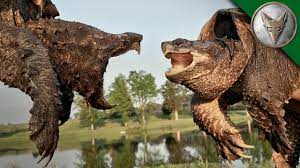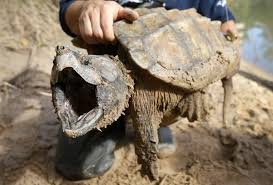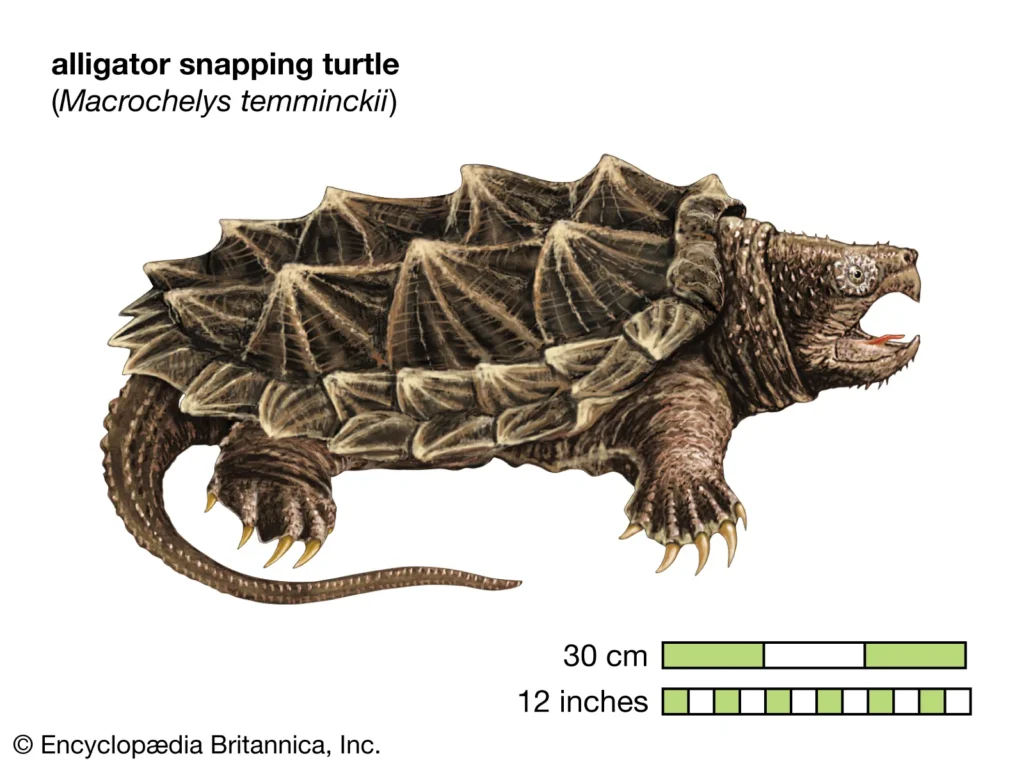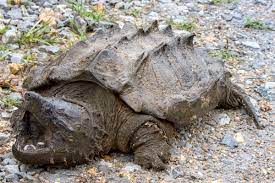The snapping turtle (Chelydra serpentina) is a remarkable creature assortment known for its evident parentage and giant genuine new developments. As the most critical freshwater turtle in North America, the snapping turtle has earned popularity for its effective jaws and unique appearance, frequently conjuring up prehistoric creatures snapshots. This article delves into the snapping turtle’s traits, habitat, conduct, and conservation reputation, supplying in-depth expertise on this captivating reptile.
Table of Contents
Physical Characteristics of the Snapping Turtle
One of the maximum hanging features of the snapping turtle is its lengthy, observed-toothed tail; it really is reminiscent of a stegosaurus and presents its prehistoric appearance. The carapace (higher shell) is another beautiful characteristic, varying in shade from tan or olive to black. The carapace is giant, challenging, and regularly included in algae, giving it a rugged and elderly appearance. It has a coarsely serrated anterior region and three longitudinal ridges running alongside its period, which further differentiates it from one-of-a-kind turtle species. In evaluation, the plastron (lower shell) is extensively small and unhinged, supplying constrained protection compared to unique turtles.
Size-clever snapping turtles are splendid. Guys generally have a carapace period between 36 and forty-three centimeters, whilst ladies vary from 28 to 37 centimeters. These measurements make the snapping turtle satisfactory as the most significant freshwater turtle in Canada and one of the boldest in terms of period and presence.
The head of the snapping turtle is large and pointed, including its intimidating look. Its jaws are distinctly strong, capable of turning in a mighty chew. The neck is lengthy and flexible, allowing the turtle to rapidly increase its head in a shielding “snap,” contributing to its not-unusual name.


Similar Species: Distinguishing the Snapping Turtle
At first glance, more youthful snapping turtles can be incorrect for eastern musk turtles because of their comparable period and small plastron. However, there are smooth versions of many of the two species. Musk turtles have an immoderate-domed shell and multiple mild strains along every side of the pinnacle, which can be absent in snapping turtles. Additionally, musk turtles lack the snapping turtle’s functional tail spikes and serrated rear shell, and they reach the size of the handiest thirteen centimeters, masses more petite than the snapping turtle.
Another species that might be stressed with the snapping turtle is the alligator snapping turtle. While both share a similar widespread look, the alligator snapping turtle has a prolonged snout with a hooked beak, more marginal scutes, and additional conspicuous ridges at the shell. These features are especially evident in adult turtles.
Snapping turtle nests are also particular. They generally include up to 45 spherical eggs, while distinctive Ontario turtle species lay oval-long-established eggs that generally range between 3 and 15. This distinction in egg form and quantity may be a key identifier while examining turtle nests in the wild.



Habitat and Range: Where Snapping Turtles Thrive
The snapping turtle is a habitat generalist, which means it can adapt to a wide range of freshwater environments. It is most commonly found in gradual-moving waters with easy mud or sand bottoms and ample plant life, which provides both food and cover. This species is exceedingly flexible and can inhabit tremendously small and isolated wetlands, ponds, or even ditches.
Snapping turtles have also been identified as thrivers in huge bodies of water, including lakes and rivers. During the chillier months, they hibernate by burying themselves in the mud or silt at the lowest of these water bodies, usually no longer far from the shore. This hibernation approach lets them live to inform the story of harsh iciness conditions.
Although regularly aquatic, snapping turtles can occasionally be placed on land, particularly during breeding, when girls search for suitable nesting sites. They are often determined to crossroads, which puts them at risk of road mortality.
Behavior and Feeding Habits
Snapping turtles are generally omnivorous, with a noticeably severe weight loss program demonstrating their opportunistic feeding behavior. They consume a significant variety of food, including aquatic flowers, invertebrates, fish, frogs, snakes, small turtles, aquatic birds, and carrion. Interestingly, approximately 90% of their eating regimen includes useless plant and animal count numbers, making them critical for preserving the cleanliness of lakes and wetlands by appearing as natural scavengers.
Despite their aquatic nature, snapping turtles aren’t particularly robust swimmers. Instead, they are regularly positioned to walk along the bottom in their watery habitats, using their strong limbs and claws to move through the dust. Unlike many different turtle species, snapping turtles rarely bask on logs or rocks. When they do “bask,” it is often by floating near the water’s surface in desire to sincerely rise from the water.
Snapping turtles are regarded for their protective behavior, particularly while on land. Unlike most other turtles, which could retreat into their shells for safety, the snapping turtle has a small plastron that offers little protection. As a result, when threatened, the snapping turtle will frequently resort to snapping aggressively with its effective jaws in an attempt to deter larger predators.
Reproduction and Life Cycle
In Ontario, snapping turtles are overdue for adulthood, with people starting to breed once they age 15 to 20. This slow maturation manner is a feature of many long-lived reptiles. The breeding season usually takes vicinity in late May or June, all through which girls go away the water to dig nests in open, sunny regions with free, sandy soil. These nesting websites are frequently located along roadsides, embankments, or seashores. Still, snapping turtles aren’t incredibly selective and could use nearly anywhere they can excavate.
A single clutch generally includes between 25 and 45 eggs, though the range can vary depending on the dimensions and age of the woman. The eggs incubate over the summer, hatching from late August to early October. Curiously, the eggs’ brooding temperature decides the hatchlings’ orientation, a peculiarity known as temperature-laid-out sex resolve (TSD).
When the eggs hatch, the youthful turtles are left to fight for themselves, as snapping turtles never again give parental consideration. The hatchlings should make their way from the home to the nearest casing of water, an experience full of danger from hunters and ecological dangers.
Threats and Conservation Challenges
Despite their adaptability, snapping turtles face numerous threats that jeopardize their long-term survival. One of the most pressing issues is habitat loss and degradation due to human activities, such as town development, agriculture, and pollution. These elements can destroy wetlands and other vital habitats that snapping turtles rely upon.
Another crucial risk is avenue mortality. Snapping turtles are often struck by vehicles as they try to crossroads, particularly during the nesting season, when girls are looking for appropriate nesting sites. The loss of grownup women should profoundly impact neighborhood populations, as their gradual replica rate makes it challenging to update misplaced humans.
Hunting and poaching also pose big dangers to snapping turtles. Although the industrial harvest of snapping turtles is regulated in a few regions, unlawful poaching nevertheless takes place, pushed by the demand for turtle meat. Studies have demonstrated that undertaking the gathering of snapping turtles isn’t generally reasonable and could prompt the extirpation of local area populations.
Notwithstanding those dangers, snapping turtles are in danger of bioaccumulating poisons from their environmental factors because of their extensive life expectancy. They accumulate weighty metals, pesticides, and uncommon poisons in their bodies as the years progress, which can harm their wellbeing.
Moreover, this pollution makes snapping turtles unsafe for human consumption, posing a hazard to individuals
who hunt or consume thos turtles.
Current Status and Conservation Efforts
The snapping turtle is, as of now, recorded as a type of Exceptional Worry under Ontario’s Imperiled Species Act, 2007, and the government’s Species In Danger Act. This designation shows the need for ongoing conservation efforts to protect the species from decline. Despite being a typical animal variety throughout bunches of its reach, the snapping turtle’s extended life expectancy and drowsy conceptive rate make it explicitly defenseless against populace declines.
The snapping turtle isn’t presently listed as Uncommonly Safeguarded under the Ontario Fish and Untamed Life Preservation Act, and that implies that simultaneously, as it’s miles analyzed as a type of issue, it does now not keep up with a similar degree of prison wellbeing as unambiguous imperiled or compromised species. In any case, the Worldwide Association for Preservation of Nature (IUCN) records the snapping turtle as a type of Least Concern universally, demonstrating that at the same time as it faces dangers, it isn’t as of now in danger of elimination worldwide scale.
Preservation endeavors for snapping turtles include natural surroundings security, road mortality alleviation, and state-funded instruction. Safeguarding and reestablishing wetlands and exceptional sea-going natural surroundings is fundamental for guaranteeing the endurance of snapping turtle populations. Also, introducing verdure intersections and signage on streets can help diminish the range of turtles killed with the guidance of vehicles.
Public education campaigns are also crucial for elevating consciousness about the threats dealing with snapping turtles and inspiring responsible conduct, along with no longer traumatic nesting girls and reporting unlawful poaching sports.
Conclusion
The snapping turtle is a first-class animal group that has made due for a long time, adjusting to a colossal scope of conditions and betting on an essential situation in sea-going biological systems. In any case, despite its strength, the snapping turtle faces several challenges that undermine its future. By knowing those challenges and taking motion to guard this iconic species, we are capable of helping make sure that snapping turtles preserve to thrive within the wild for generations to return.
Whether you come upon a snapping turtle in a serene pond or see one crossing a street, we must recognize these historical reptiles and do what we can to protect them. Their endurance isn’t only a demonstration of their flexibility but also a reflection of our commitment to saving the homegrown worldwide.
FAQs About Snapping Turtles
Q: Why is it referred to as a snapping turtle?
A: The snapping turtle gets its name from its strong jaws and propensity to “snap” simultaneously when undermined. This protective behavior entails fast lunging ahead and biting with enormous pressure, which protects it from predators.
Q: Are snapping turtles secure?
While snapping turtles may be aggressive when threatened, they may typically be steady if left alone. They pose little threat to humans besides being provoked or dealt with improperly.
Q: What eats a snapping turtle?
Due to their length and hard shell, grownup snapping turtles do not have many natural hunters. Notwithstanding, eggs and more youthful snapping turtles are inclined to hunters like raccoons, foxes, flying predators, and enormous fish.
Q: How large is a one hundred-one year-antique snapping turtle?
It’s extraordinary for a snapping turtle to live to 100 years. Still, if it did, its size would no doubt rely on its current circumstances. Commonly, enormous snapping turtles can acquire up to 18 creeps in shell period and weigh more than 30 kilos, even though colossally immense people might be considerably greater.
Q: Are snapping turtles aggressive?
Snapping turtles can be competitive once they enjoy threatened, in particular on land where they sense extra inclined. They may be usually more docile in water and prefer to avoid a war of words.
Q: Are snapping turtles mating or preventing?
It can be challenging to differentiate between mating and preventing in snapping turtles, as each behavior can incorporate biting and bodily touch. However, sooner or later of mating, the conduct is more sustained and regularly takes place inside the water.
Q: Do snapping turtles eat meat?
Yes, snapping turtles are omnivores and consume plenty of ingredients, which encompass meat. Their weight loss plan can encompass fish, amphibians, small mammals, and carrion, further to aquatic flora.
Q: Do snapping turtles have teeth?
No, snapping turtles do not have teeth. Instead, they have sharp, beak-like jaws that they use to tear food.
Q: Can a snapping turtle break bones?
A snapping turtle’s chew is robust and may cause extreme harm, but it won’t break human bones. However, without problems, it could weigh down more minor, more sensitive bones like the ones of small animals.
Q: What is the lifespan of a snapping turtle?
Snapping turtles can live for several a long time, usually around 30 to 40 years in the wild. Some have been acknowledged to stay over 50 years in captivity.
Q: How rapid is a snapping turtle?
Snapping turtles typically move on land gradually, but they can circulate instead briefly at the same time as provoked. In water, they may be extra agile, although they are no longer rapid swimmers, in contrast to a few extraordinary aquatic animals.
Q: How huge is a snapping turtle?
Grownup snapping turtles generally have a shell length of eight to 18 inches and may weigh between 10 and 35 pounds. More excellent individuals can show up at over 20 creeps in shell length and weigh more than 50 kilos.
Q: How sturdy is a snapping turtle’s mouth?
A snapping turtle’s chunk force is massive, capable of exerting 208 to 226 Newtons (47 to fifty-one pounds-pressure). This strength permits them to bite through bones and thorny vegetation.
Q: Is a snapping turtle a tortoise?
No, a snapping turtle isn’t a turtle. Turtles are land-living reptiles with domed shells while snapping turtles are sea-going and capable of complementing extra smoothed-out shells.
Q: How do you tell a turtle’s age?
Estimating a turtle’s age may be difficult. One technique is counting the growth rings on the shell’s scutes, although this isn’t always accurate. The shell’s dimensions and state of affairs can offer a few clues.
Q: How smart are snapping turtles?
Snapping turtles are not considered sensible compared to mammals or birds. However, they showcase problem-solving competencies and might learn from experience, particularly in their natural habitats.
Q: Can a toddler snapping turtle hurt you?
Sometimes, minimal snapping turtles can nibble, and their jaws aren’t sufficient to rationale incredible damage to individuals. In any case, it’s embraced to address them with care to avoid harm.
Q: Is a turtle bite toxic?
No, turtle bites are not toxic. However, like every animal bite, a turtle chunk can cause contamination if it is not properly wiped and treated.
Q: Is my snapping turtle a boy or a lady?
Determining the intercourse of a snapping turtle can be difficult. Males usually have longer tails with the vent (cloaca) placed further from the body than females. In contrast, females have shorter tails with the vent toward the frame.
Q: Are snapping turtles shy?
Snapping turtles are commonly shy and reclusive in the water, where they sense safety. On land, however, they are extra aggressive and protective because of their vulnerability.
Q: Do snapping turtles lay eggs?
Yes, girl snapping turtles lay eggs, generally between 25 and 45, in an unmarried clutch. They dig nests in sandy or clean soil, regularly near water, wherein they deposit their eggs.
Q: Are snapping turtles dinosaurs?
Yet again, Sometimes snapping turtles are not dinosaurs; they’re essential for an old heredity of reptiles that dates more than 200,000,000 years, making them remote ones of dinosaurs.
Q: What are snapping turtles particular for?
Snapping turtles are critical to their ecosystems by controlling fish populations, scavenging useless animals, and helping to preserve healthy aquatic environments.
Q: Can a snapping turtle leap?
Snapping turtles cannot leap. They aren’t built for such actions and generally depend on their solid legs for walking and digging rather than jumping.
what do snapping turtles eat. what food do snapping turtles eat. snapping turtle. common snapping turtle. baby snapping turtle .giant snapping turtle. alligator snapping turtle news. snapping turtles. what do snapping turtles eat. florida snapping turtle. pictures of snapping turtles. alligator snapping turtle for sale. common snapping turtle shell. snapping turtle shell. snapping turtle pictures. michigan snapping turtle. snapping turtle boots.